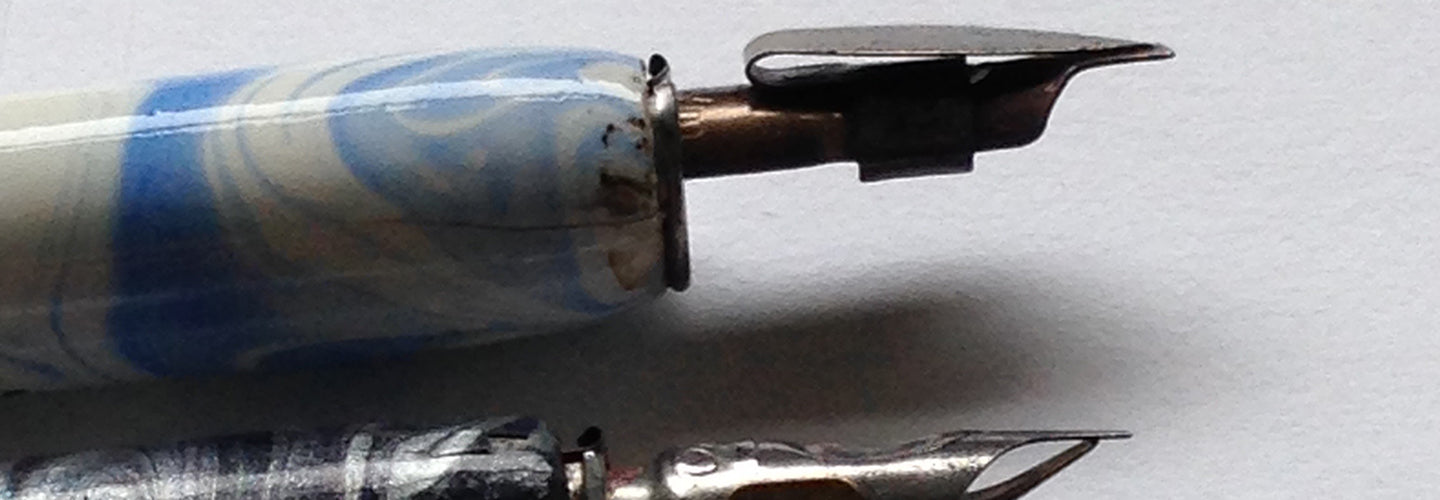
Why Won’t My Pen Write Well?
As a calligrapher, you’ll have (hopefully) experienced the feeling of your writing tool gliding across the paper, leaving beautiful marks behind it as it goes.
On other days, your relationship with the pen feels less like a sensual dance, and more like an embittered battle!
In fact we’re aiming for the pen, the paper, the ink and the calligrapher to be working collaboratively and at their best. If any one of those is not in harmony then the whole writing experience is not at its best.
This article focuses on the nib of the pen – but remember that this is only one of the 4 elements that need to be cooperating to give beautiful lettering.
Before focusing on a broad edged metal nib, a couple of thoughts on other pens: a felt tip calligraphy pen is a great tool for getting started, but once the nib has lost its sharpness or the colour is running out, we really have to accept that it’s a disposable item.
Fountain pens work best if they’re kept meticulously clean – if you have ever had waterproof ink in your pen then you’re in trouble, as it will have dried (waterproof) and will not be moved.
Focusing now on a broad edged metal nib, there are two reasons for a nib not writing well that cover 98% of the problems you’ll experience.
They are CLEANLINESS and RESERVOIR FITTING.
Pen Cleanliness
With a new nib, the problem is over-cleanliness. Many nibs come with a protective coating on them to ensure that they arrive with the customer looking pristine. This coating repels liquid, and if you leave it on your nib, the nib will be trying to repel the ink onto the page, which is likely to cause unwanted blots.
You can tell if you have the coating on a nib because liquid will sit in bobbles on the nib (bottom nib). The ink clings on to a nib that has had the coating removed (top nib).

Preparing a nib can be done by dipping it in boiling water for a second or two, or holding over a match flame for a second or two.
A nib that is not brand new might no longer write because it is not clean. It’s worth spending time gently cleaning the nib – some good kitchen roll lightly dampened with water is enough – you’ll see if there is old ink or paint coming off.
Be careful not to use a cloth that leaves tiny fragments of lint on the nib – these too will cause issues.
A nib can get tiny particles of dirt (such as dried ink) in the slit. If the slit is held open by the dirt – even by just a tiny amount – the nib is no longer in its best state to write. Try holding the nib to the light: if you can see light through the slit then you need to clean it. If this doesn’t resolve the problem then the nib is distorted in some way and fixing it will be tricky.
The top nib is distorted and beyond hope! The middle nib has dirt in the slit – there is the tiniest gap – you can see the white of the paper. The bottom nib is fine.

Reservoirs
Reservoirs are tricky little things. It’s worth remembering that their ONLY job should be to hold ink ready for use.
On some nibs including the Brause Bandzug and Speedball C Style Nibs, the reservoir is on top of the nib, and it is unlikely that it is causing a problem. With Mitchell and Leonardt nibs where the user has more choice about how it is fitted, this can bring issues.

A nib with a well fitted reservoir should be able to write several words (if not several lines of words) before you can see that the reservoir is empty. A common mistake is to keep dipping every few strokes. All that is happening is that the ink clinging to the outside of the nib is being used in the lettering and the ink in the reservoir is just staying where it is.
If this sounds like you, the first thing to do is to take the reservoir off entirely and see how the nib behaves. If the nib is OK (and it is likely it will be) you should be able to brush some ink onto the top of the nib and it will write smoothly and well, but not for many letters as it will dry up.
You should feel like the nib is gliding across the paper depositing a trail of ink as it goes. (If it feels like you’re having to press to get it to write, then there’s something wrong).
Often reservoirs are too tight. This is understandable because the manufacturer may have attached it tightly so it didn’t fall off in transit. As a calligrapher you want the reservoir to be “just tight enough” and no more. If you were to shake your pen violently (not recommended!) the reservoir might fly off – this is perfect!
You may need to adjust the wings of the reservoir with your thumbs or long nosed pliers. Also be aware that Mitchell reservoirs don’t fit terribly well on Leonardt nibs and vice versa.

The reservoir should be positioned under the nib, with its end 2-3mm away from the writing edge of the nib. The tip of the reservoir should just touch the pen nib, but not press on it.


A reservoir made from soft metal (such as a drinks can) is really easy to make with scissors, and works really well.

Now if you carefully fill the reservoir with ink, it should flow steadily to the edge of the nib where you can control the creation of beautiful letters.
Shop our range of Nibs, Dip Pens and Reservoirs.
